Popular Woodworking 2003-06 № 134, страница 88
look for and told us what you can do at home to improve any shop apron. Check out her analysis, "Preventing Apron Failure" below. Seamless Results Venturing into the world of woodworking attire left us feeling frustrated. We all had the perfect shop apron in mind but we certainly didn't see it. Therefore, we were unable to hand out an Editor's Choice award to any of the aprons. We were, however, able to award Duluth Trading Co.'s shop apron our Best Value award. Although the apron presented some flaws, for $20 it's a good deal and it won our respect compared to the other aprons in our review. You can read our comments about each apron on the following pages. And do check out "Preventing Apron Failure" below. You'll not only walk away with a better understanding as to why shop aprons fail, but you'll feel better about your next shop apron purchase, knowing you can fix some of its flaws at home. PW BUCKET BOSS SUPER BIB The straps on this apron are durable but we would like to see crisscross straps. The pockets located around the waist excel at collecting dust, not a feature you want to tout. The stitching is similar to our failed shop apron, shown below.This apron features many pockets but it's not as overloaded as others in our review. We wish the pencil pockets were longer. This is a good apron, if only it featured better seams. It's no fun constantly picking up tools that fall out of busted pockets when you bend down. Every home-center store has a bin full of cotton aprons. Although it might be sold as one, this apron is not meant for a woodworker. The first thing to get soiled in a woodworking shop is the waist and thigh area - not the chest. And its minimal pockets (although slightly more durable than some in our review) only allow for a few stored tools. But, despite its deficiencies, we have to recognize its low cost: $3. Perhaps the best thing to do would be to buy 10 of them and sew a couple together. This apron sports many features others miss, such as the split up the middle of the bottom.The pockets are nicely arranged and close up when bending over, and the crossover neck strap is good.Although heavy-duty, the material is hot and stiff. The stitching on the pockets is worrisome. Overall a good design but we're too concerned with the choice of material and durability to justify spending $50. PREVENTING APRON FAILURE Senior Editor Christopher Schwarz wore the Bucket Boss shop apron (right) for six months before it fell apart. After a little stitch work, the apron lasted three more months before it was finally retired. So we mailed the failed apron to seam guru Ann Braaten, a graduate instructor at the University of Minnesota's Department of Design, Housing and Apparel. Following are her comments along with some recommendations for improving similar shop aprons at home. "What failed on the Bucket Boss apron was not the seam, stitches or thread, but the fabric," Braaten wrote in an e-mail.The strength of an apron's fabric is the most important feature. According to Braaten, a seam should be slightly weaker than the fabric. Mending a few broken stitches is easier than mending torn fabric. The pockets on this apron are stitched using a "straight lock stitch," with "back stitching" at the ends of the seams.According to Braaten, lock stitches (the most common stitches in today's sewn products) are the type of stitches made by a traditional home sewing machine.A top thread and a bottom thread are twined together, which "locks" the stitch in place.A back stitch is created by stitching forward three to four stitches and then reversing the direction and stitching backwards three to four stitches, Braaten wrote. The seam is sewn and then the back stitching procedure is repeated at the other end of the seam. The extra stitches strengthen the beginning and the end of the seam. The apron at right was made using cotton canvas fabric. According to Braaten, cotton canvas is a relatively strong fabric because it packs a large number of threads per square inch. The fabric is woven, meaning it has interlacing horizontal and vertical threads. This woven design creates strength, but isolating stress to a few single threads can cause failure. Why? Each individual thread that makes up the fabric is relatively weak, compared to nylon or polyester. Below you can see where the pockets have become disconnected with the fabric.According According to Ann Braaten, a graduate instructor at the University of Minnesota's Department of Design, Housing and Apparel, seam, stitch and thread type didn't fail, rather the strength of the apron's fabric was too weak, causing the pockets to rip away from the apron's body. 86 Popular Woodworking June 2003 |








